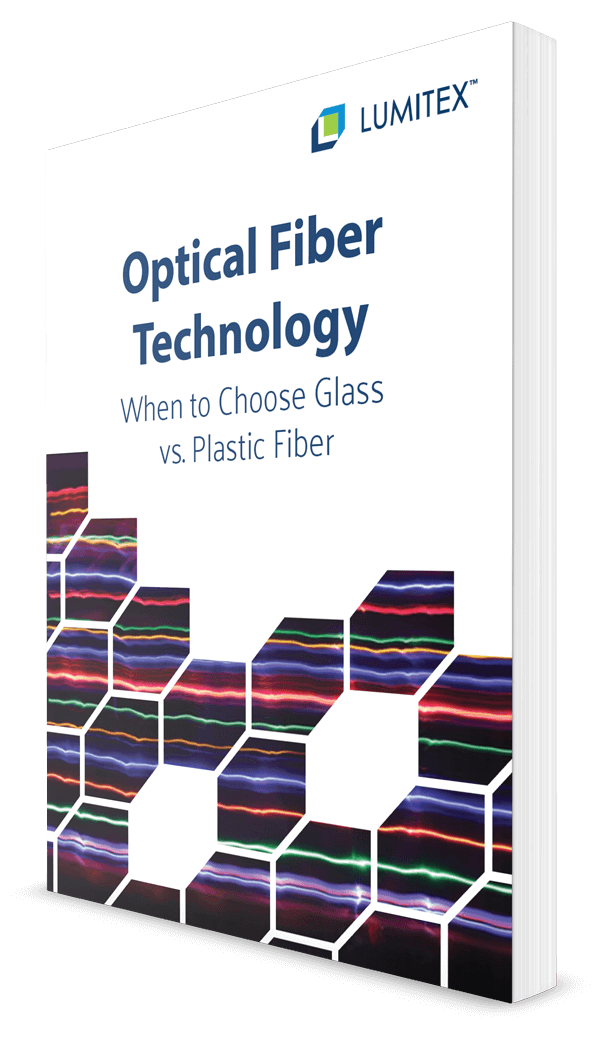
Glass vs. Plastic Optical Fiber
Glass optical fibers have higher information transmission capacity with lower loss. They are ideal in corrosive environments or extreme temperatures. Plastic optical fibers have great flexibility and are lighter in weight. They can withstand vibration and unstable environments.
Optical fibers are most commonly made of 3 materials: large core plastic fiber, small core plastic fiber, and glass fiber. Large and small core fiber optics differ in diameter and manufacturing process, but are essentially the same in terms of performance and characteristics. Therefore, the main thing to consider are the differences between plastic and glass fiber optics.
In this article, we cover the differences between glass and plastic fiber and how to determine when it is best to use one over the other. Although similar, they have marked differences in their applications.

Glass Fibers
Glass fibers typically consist of a pure glass (SiO2) core with a less pure glass or plastic cladding. There are many benefits to glass fibers, but as with plastic there are also some downfalls.
Pros –
- Have a larger numerical aperture, allowing more light into the system – 0.25-1
- Able to withstand and adapt to more extreme temperatures
- Can handle wet and corrosive environments without degrading
- Able to transmit a much wider spectrum ranging from UV, visible, and infrared light (200-2200 nm)
- Typically exhibit less losses through the system
Cons –
- More limited on diameter size - Only have diameters of 0.05 mm – 0.15, typically come in bundles
- More fragile and prone to breakage if not handled correctly
With these characteristics, the main applications for glass fiber are communication, sensor, and measurement systems. Due to the high transmissivity and low loss factor, they are the ideal choice for long-distance, high-speed communication applications. They are also more ideal if they will be used in corrosive environments or extreme temperatures.
Plastic Fibers
Plastic fibers typically consist of a PMMA (acrylic) or polycarbonate core with a silicone resin cladding. There are many benefits to plastic fibers, but there are also some downfalls.
Pros –
- Traditionally come in a wide variety of diameters ranging from 0.15-2 mm (small core) and even up to 20 mm (large core)
- More flexible and able to bend farther without cracking or breaking
- Able to withstand vibration and unsteady environments
- Lower material cost and typically less complex manufacturing
Cons –
- More narrow numerical aperture – 0.48 - .063
- Not able to withstand harsh environments and will easily degrade/yellow overtime
- Can only transmit a narrow spectrum of visible light (400 - 700 nm)
These characteristics make plastic fibers preferred for more illumination and decorative applications, such as backlighting and trim lighting. Due to the flexibility and vibration resistance of plastic fibers, they are also great for automotive and industrial lighting purposes.
Also, although a narrow spectrum of transmitted light is listed as a con, this is actually a pro for medical instruments. Plastic fiber optics are often used to illuminate the inside of a body during surgery due to the fact that certain wavelengths outside of visible light are harmful and cannot be present.
Glass Fiber Optics Vs. Plastic Fiber Optics

Conclusion
Fiber optics are used in a wide variety of applications. The best material choice depends on what type of application your fiber will be going in to.
While glass is great for high transmissivity solutions, it is more brittle and will likely not hold up in more rough applications like plastic will.







Comments